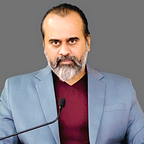On Mundaka Upanishad: That which the self-knowers know
The following excerpt is from a samvaad (dialogue) session with Acharya Prashant.
हिरण्मये परे कोशे विरजं ब्रह्म निष्कलम् ।
तच्छुभ्रं ज्योतिषं ज्योतिस्तद्यदात्मविदो विदुः ॥hiraṇmaye pare kośe virajaṃ brahma niṣkalam
tacchubhraṃ jyotiṣaṃ jyotistadyadātmavido viduḥIn a supreme golden sheath, the Brahman lies, stainless, without parts. A Splendor is That, It is the Light of Lights, It is That which the self-knowers know.
~ Verse 2.2.10
✥ ✥ ✥
Acharya Prashant (AP): A very rich verse, consisting of several parts, each complete in itself. We shall look at them one by one.
“In a supreme golden sheath the Brahman lies” — and the Upanishads refer to the Truth repeatedly this way. Elsewhere also say the scriptures, that the face of Truth is covered with gold. And here again, we see: “In a supreme golden sheath the Brahman lies.” What is it that the sage is trying to say?
